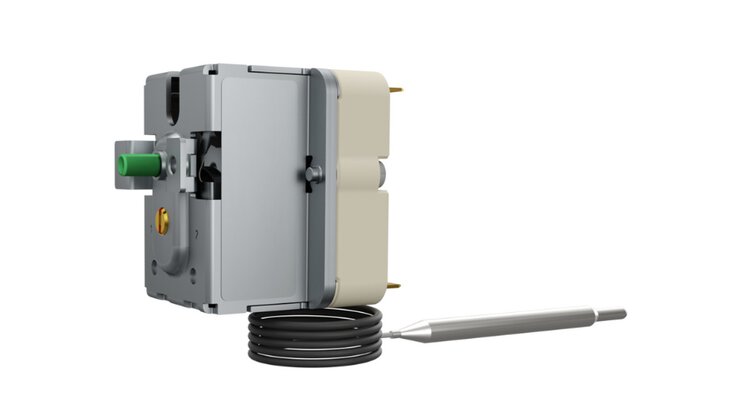

Frost protection thermostat versus universal industrial thermostat - key differences
Have you ever wondered what the differences are between a refrigeration thermostat and a universal industrial thermostat? Both are designed to maintain a comfortable room temperature in the home or industrial plant and equipment. However, despite their similarities, they differ in their application and principle of operation. Let's take a closer look at what the differences are between these two types of thermostat.
What is a refrigeration thermostat?
The refrigeration thermostat is a key component of many appliances that we encounter every day. It is used primarily in refrigerators, but also in air conditioners or cold stores. Its main task is to maintain a specific, low temperature.
How does the refrigeration thermostat work?
It works by detecting the temperature and activating the cooling process when the temperature exceeds a predetermined threshold - the setpoint. In practice, the refrigeration thermostat is connected to a temperature sensor that constantly monitors the thermal conditions in a given environment, such as inside a cold store. When the sensor detects that the temperature has exceeded the set threshold, the thermostat activates the cooling mechanism, usually by switching on the compressor.
The thermostat itself is usually a dual-mode device, meaning that it operates in an 'on/off' mode. - it is capable of either activating the cooling system or turning it off. Some thermostats have more advanced control features and can offer infinitely variable temperature control through different levels of cooling system operation.

Electronic controller/controller of the freezing process for applications in cold stores, display cases or refrigerated counters JUMO eTRON M100 (item no. 701061)
What is an industrial thermostat?
A heating thermostat is a control device used in heating systems to maintain a constant temperature in a given environment. Like a refrigeration thermostat, an industrial thermostat uses temperature sensors to monitor conditions in a designated area. When the temperature drops below the designated level, the heating thermostat activates the heating system - for example, turning on the furnace - to bring the temperature back to the desired level.
Industrial thermostat - applications
In an industrial context, the heating thermostat is designed for use in a variety of applications, from maintaining a constant room temperature in production halls, for example, to controlling industrial processes and installations that require precise temperature control, to applications in the food and beverage or chemical industries where a constant temperature is crucial to maintaining product quality or process safety.

Built-in thermostats JUMO heatTHERM P100 (item no. 602051)
Comparison of a refrigeration thermostat and a universal industrial thermostat
Although both universal industrial and refrigeration thermostats serve the purpose of controlling the temperature, they differ in key ways. While a refrigeration thermostat activates when the temperature is too high, a heating thermostat activates when the temperature falls below the setpoint. This is the key difference between the two devices.
A refrigeration thermostat is designed for use in refrigerators, air conditioners or coolers, among others, while an industrial thermostat is widely used in heating systems such as central heating furnaces, industrial boilers, fluid heating systems or equipment that maintains a constant temperature in industrial processes such as food production, chemical production or metal heat treatment.

The refrigeration thermostat is designed for use in refrigerators, air conditioners or cold stores, among others
JUMO thermostat range
One of the key aspects to consider when choosing a thermostat is whether it is designed for heating or cooling. In the case of JUMO thermostats, many are applicable to both heating and cooling systems.
For example, panel-mounted thermostats such as the JUMO heatTHERM P100 and JUMO heatTHERM P300 are often used in heat generators, heating units, heating elements and canteen kitchen technology. On the other hand, we also offer frost protection thermostats such as JUMO frostTHERM-AT/DR and JUMO frostTHERM-ATE, which are used in the construction of air-conditioning and refrigeration systems, mechanical engineering and plant construction. In addition, we have thermostats with railway approvals that prevent, among other things, brake fluid from freezing on the train.

3-phase panel-mounted thermostat JUMO heatTHERM P300
Regular thermostats versus cooling thermostats - summary and conclusions
In summary, both cooling and heating thermostats are key components of temperature management systems, but their operation and application are different. A cooling thermostat activates the cooling system when the temperature exceeds a set threshold, while a heating thermostat activates the heating system when the temperature falls below a set value. The different applications of these thermostats mean that they are tailored to the specific needs and requirements of different systems and processes. Understanding these differences is key to optimal thermostat selection and use.
- ${title}${badge}

